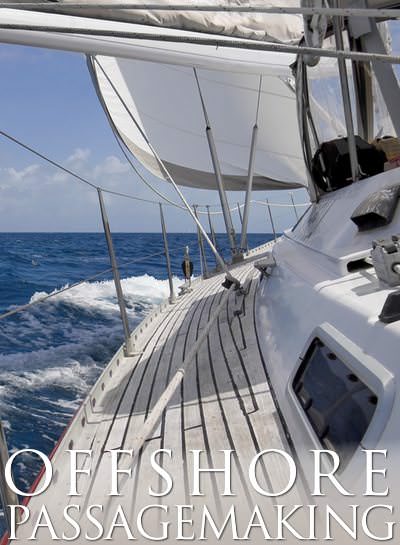ASA 108, Offshore Passagemaking
Able to skipper a sailing vessel on extended offshore passages requiring celestial navigation. Knowledge of long-term passage planning, offshore vessel selection, sail repair, offshore first aid, watch-keeping, emergency procedures, abandon ship protocols, safety and seamanship.
Knowledge
Passage Planning
1. Plan a passage across the North Atlantic or Pacific and state the advantages, disadvantages and hazards of various routes, utilizing Ocean Passages for the World, climatic charts, Great Circle plotting charts, plotting instruments, etc.
2. Plot a series of rhumb lines on a Mercator chart to approximate a great circle route.
3. Describe the publications required for prudent navigation on an offshore passage including:
- Coastal charts and publications
- Work sheets
- Ocean Passages for the World
- Nautical almanac
- Sight reduction tables
- Plotting sheets
Voyage Preparation
4. Describe the effect of the following factors when selecting a vessel for an offshore ocean passage of at least 1000 miles:
- Hull shape
- Hull construction
- Displacement
- Rudder
- Keel
- Rig
- Machinery
- Water capacity
- Fuel capacity
- Sails
- Interior layout
5. List essential items for minor repairs to vessel, rigging and sails.
6. Describe various items required to prevent chafe.
7. Describe the advantages and disadvantages of three self steering methods/devices.
8. Plan meals for a minimum of four people on a seven day offshore passage.
9. Describe proper methods for preserving/storing food and the expected storage life of different types of food.
10. Describe the following factors to be considered when selecting crew members for an offshore passage:
- Health
- Attitude
- Compatibility
- Experience
- Physical capability
11. Describe suitable clothing for an offshore voyage.
12. State a source of obtaining advanced first aid information while on an offshore passage.
13. Identify and describe the basic treatment of potential medical problems.
14. Describe methods of preventing injury to the cook or nearby persons while cooking at sea.
15. List items carried in an offshore first aid kit.
16. Prepare and file a passage plan.
Shipboard Routines
17. Describe three (3) watch-keeping systems and the advantages and disadvantages of each.
18. Describe alternate watch-keeping arrangements in the event crew members are incapacitated.
19. Describe the duties of the on-watch and off-watch crew.
20. Establish a routine maintenance schedule to periodically check the following items:
- Bilges
- Sea cocks
- Rigging
- Hatches
- Helm
- Galley & supplies
- Fuel and water
- Machinery
- Safety equipment
- Electronic equipment
21. Set up a routine vessel cleaning schedule.
Emergency Procedures
22. Describe how to rig a trailing man overboard (MOB) line with an alarm.
23. Describe an alternative method of alerting the crew to MOB situation. State other emergency situations when you should limit the use of this device.
24. Describe what actions should be taken when a MOB is not located on the first pass.
25. Describe how to organize the crew for a routine fire drill.
26. Describe possible methods of jury rigging a vessel in the event of dismasting and what course should then be assumed.
27. Describe proper actions to be taken after a vessel has been struck by lightning.
28. List essential survival items to be kept in a standby kit in the event the vessel must be abandoned offshore.
29. Describe additional useful survival and rescue items.
30. State the dangers that might be encountered in a small life raft at sea.
31. List safety equipment that should be carried in addition to Federally required items.
Navigation Rules
32. Describe, using diagrams as appropriate, the applicable rules for an offshore sailing vessel, as found in the USCG Navigation Rules and Regulations Handbook.
33. List the 16 International Distress Signals found in Rule 37 of the USCG Navigation Rules and Regulations Handbook.
Skills
34. Act as skipper and crew on an offshore passage of no less than 72 hours and 100nm without touching land.
35. Obtain a celestial fix using a sun-run-sun or three (3) celestial bodies.
36. Obtain a celestial heading check.
37. Apply all elements of ASA 107, ASA Celestial Navigation
Call Northern Breezes Sailing School at 763-542-9707 to register or with questions.
